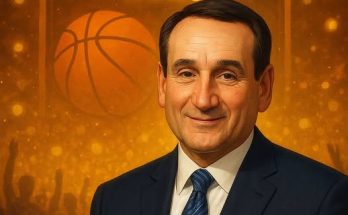The Ryder Cup has always been one of the most electric events in sports. Beyond the prestige of golf’s greatest international competition, it’s also a cultural gathering ground where legends, celebrities, athletes, and rising stars from all corners of the sporting world converge. But in the latest edition of the tournament, what caught the world’s attention wasn’t just a putt to seal a point or a European comeback—it was the surreal moment when basketball’s eternal icon Michael Jordan stood alongside the future of the sport, Cooper Flagg. The photograph, the video clip, and the social media frenzy that followed weren’t simply about golf, basketball, or celebrity cameos; they became a generational moment, a symbolic passing of the torch, and a glimpse into the evolution of greatness.
Michael Jordan, often regarded as the GOAT of basketball, carries an aura that transcends time. Even long after retirement, his presence at any sporting venue triggers awe, admiration, and respect. From his six championships with the Chicago Bulls to his endless highlight reel of clutch performances, Jordan represents the pinnacle of competitive spirit. On the other side of this historic image stood Cooper Flagg, an 18-year-old basketball prodigy from Maine whose name has been swirling in hoops conversations for years. Touted as one of the most gifted high school players of his generation and a surefire NBA lottery pick, Flagg has become a symbol of the future—youth, raw potential, and boundless expectations.
So, when these two figures shared a moment on the grounds of the Ryder Cup, it was more than a casual photo-op. It was a rare visual alignment of past and future—Jordan, the embodiment of what it means to be the best, and Flagg, the face of what’s to come. The internet exploded instantly, with fans, athletes, and analysts posting captions like “GOAT meets the Future,” “Basketball royalty,” and “History in one frame.” The response was unanimous: this was a cultural moment that transcended generations.
For Cooper Flagg, this was more than just a handshake or a smile. Growing up, he had watched hours of Jordan highlights, absorbing the mythos of the player who defined competitiveness for decades. Flagg has already built a reputation as a relentless two-way player, showing intensity on defense and poise on offense—traits Jordan himself mastered. To stand next to his idol, the man whose competitive DNA is woven into basketball’s fabric, wasn’t just a fanboy experience—it was a preview of expectations. For many, it looked like Jordan was silently blessing the young phenom, a gesture that carried weight beyond words.
But why did this particular meeting resonate so much? Part of the answer lies in timing. Sports culture thrives on symbolism, and the idea of “generations crossing paths” has always captivated fans. When Kobe Bryant once shared advice with a young LeBron James, it felt monumental. When Lionel Messi took a photo with a child who later became Kylian Mbappé’s teammate, it became iconic. The Jordan–Flagg moment taps into that same mythology. Fans are always searching for continuity—proof that greatness doesn’t fade, it evolves, passed down through interactions, mentorships, and shared moments.
Social media’s reaction amplified the magnitude. Twitter, Instagram, and TikTok were filled with memes, edits, and captions. One fan wrote, “This is like seeing Zeus shake hands with a young demigod.” Another joked, “Jordan better not bet against him,” referencing the legend’s love for competition and wagers. Highlight reels of Jordan’s best moments spliced with Flagg’s high school dunks and blocks quickly made the rounds, edited with music that elevated the moment into myth. In a way, the internet helped script this encounter into a storybook, turning what could have been a fleeting handshake into a symbol of destiny.
The Ryder Cup itself benefited enormously from the buzz. While golf has its own legends like Rory McIlroy, Tiger Woods, and Jon Rahm, the crossover attention from basketball fans injected fresh energy. Suddenly, people who might never tune into golf highlights were watching Ryder Cup clips just to catch a glimpse of Jordan and Flagg. In today’s age, where visibility across multiple sports is as powerful as the sport itself, this kind of cross-pollination creates viral moments that sustain cultural relevance.
For Jordan, this wasn’t just a public appearance—it was another reminder of how he remains basketball’s eternal standard. Even in retirement, he has become the north star for every young player dreaming of NBA glory. Flagg, like many before him, must now navigate the weight of comparisons. Already, fans and pundits are placing enormous expectations on his shoulders, some daring to suggest that his trajectory could lead him toward Jordan-like dominance. Whether fair or not, these comparisons speak volumes about how hungry fans are for the next transcendent figure.
What makes Flagg particularly compelling is his poise. Unlike many prospects who crumble under the hype, he has embraced the spotlight with maturity. Known for his work ethic, defensive intensity, and polished skill set, Flagg represents a new era of American basketball talent—one that blends old-school grit with modern versatility. Watching him stand beside Jordan reminded fans of the thin line between potential and legacy. In that moment, it wasn’t just about what Flagg is now, but what he could become.
The moment also highlighted the cyclical nature of sports storytelling. Every generation needs its heroes, its defining players, its symbols of greatness. Jordan was that figure for the 80s and 90s, LeBron James carried that mantle for the 2000s and 2010s, and now, fans are scanning the horizon for who will define the 2020s and beyond. Cooper Flagg, though still unproven at the NBA level, has positioned himself as a candidate. Seeing him next to Jordan didn’t crown him prematurely—it placed him in the narrative, gave fans a visual of the continuity they crave.
The ripple effects of this meeting will likely linger. For Flagg, the memory will serve as motivation, a reminder of the expectations attached to his journey. For Jordan, it’s another chance to cement his role not just as a past champion but as an eternal figure in the basketball ecosystem, someone who continues to shape narratives long after his final game. For fans, it’s a piece of cultural history—a photograph, a handshake, a clip—that encapsulates the magic of sport.
The Ryder Cup, ironically, may fade into the background of this particular storyline. While golf purists will remember the scores, the clutch putts, and the triumphs of the teams, the broader public will remember that this was the weekend Michael Jordan and Cooper Flagg shared a viral moment. That, in itself, speaks to how sports culture has evolved. The games matter, but so do the stories, the images, the connections that make us believe in something bigger than wins and losses.
In the coming years, as Flagg begins his NBA career, this photograph will resurface time and again. If he lives up to the hype, it will be seen as foreshadowing, the moment the GOAT himself acknowledged the new face of the game. If he struggles, it will be remembered as a “what could have been” curiosity. Either way, it’s etched into the cultural memory. These moments are rare, unpredictable, and powerful. They remind us why we follow sports—not just for the results, but for the human stories that connect eras, legends, and dreams.
Ultimately, the phrase that flooded the internet—“GOAT meets the Future”—captures the essence of what happened. Michael Jordan, the greatest of all time, stood with Cooper Flagg, a young man with the potential to define the next chapter of basketball. In that single moment, time collapsed. Past, present, and future converged on the fairways of the Ryder Cup. And for fans, it was magic.
The internet may move quickly, devouring one viral moment after another, but some images have staying power. This was one of them. Years from now, when Cooper Flagg takes the court in an NBA jersey, when he plays under the bright lights of playoff basketball, or perhaps even when he chases championships, people will look back at this photo with renewed meaning. They’ll say, “We should have known. The torch was already in his hands.”
The Ryder Cup delivered a spectacle in golf, but it also gave us something far greater: a snapshot of legacy meeting potential. Michael Jordan and Cooper Flagg didn’t just break the internet—they reminded us of why sports, in all their unpredictability, remain the greatest storyteller of all.



